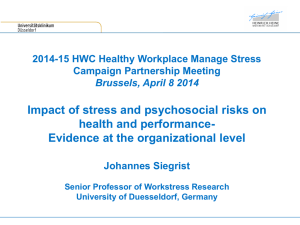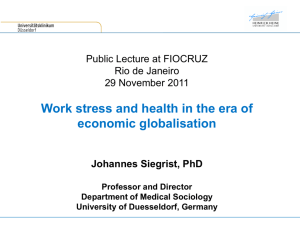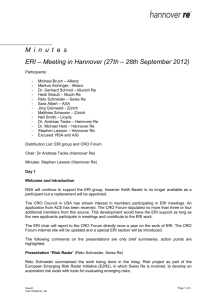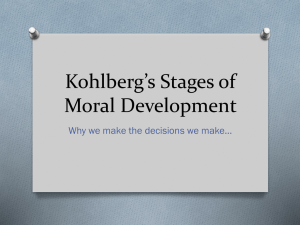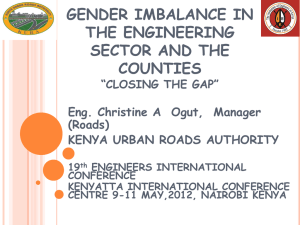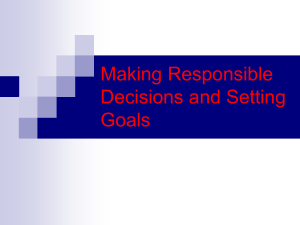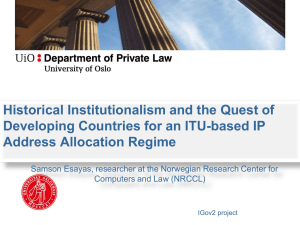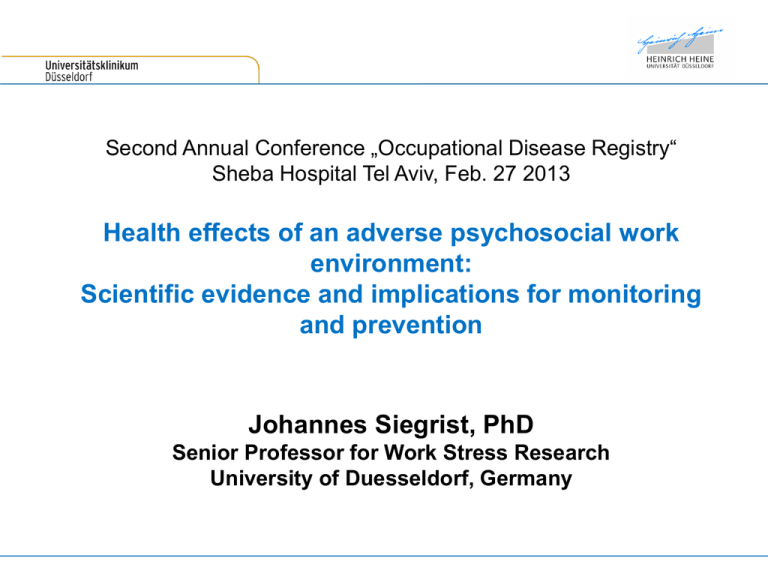
Second Annual Conference „Occupational Disease Registry“
Sheba Hospital Tel Aviv, Feb. 27 2013
Health effects of an adverse psychosocial work
environment:
Scientific evidence and implications for monitoring
and prevention
Johannes Siegrist, PhD
Senior Professor for Work Stress Research
University of Duesseldorf, Germany
Importance of work for health
Work …
provides a source of regular income and related
opportunities
provides a source of personal growth and training
opportunities
provides social identity, social status and related rewards
enables access to social networks beyond primary groups
influences a person’s self efficacy and self esteem
exposes a person to differential quality of work
environment
Importance of work for health (cont.)
• Job loss/ long-term unemployment is an
established risk factor of elevated morbidity and
mortality from addiction and stress-related
disorders (esp. CVD, depression) (Gallo et al.
2004, Voss et al. 2004)
• Yet, among employees with poorest quality of
work mental health is getting significantly worse
over time than in the case among unemployed
people (Butterworth et al. 2011)
Quality of work and health
Traditional focus: workplace
Chemical & physical hazards and specific ergonomic
conditions reduce employees’ health and increase
injury risk
Domain of occupational medicine and safety
Modern focus: work organization and employment
conditions
Specific features enhance or reduce employees’ health
through psychosocial stress-related mechanisms
Domain of ‚new‘ occupational health research and
policy
Significant changes in the nature of
work and labour market
Increase of work pressure, pace of work,and competition,
including ‘high power work organization’ (impact of economic
globalization)
High demand for flexibility, mobility, and adaption of workers
to new taks/technologies
Fragmentation of occupational careers, de-standardized or
atypical work, and growing job instability/insecurity
Increase of service and IT professions/occupations with high
psychomental/emotional workload
Segmentation of labour market; social inequalities in quality
of work and employment
Effects of economic globalisation: Labour
market consequences in developed countries
Increased pressure of rationalisation
(mainly due to wage competition)
Downsizing, Merging, Outsourcing
Work
intensification
Job
insecurity
Low wage /
salary
High work pressure (e.g. overtime work) and
job instability (e.g. downsizing) are unhealthy!
Examples of recent evidence:
Overtime work (>11 hrs/day):
risk of severe depression: HR 2.4
risk of incident CHD:
HR 1.7
(Virtanen M et al. PLoS One 2012, Eur Heart J 2010)
‚Surviving‘ severe downsizing:
risk of all-cause mortality: HR 1.4
risk of CHD mortality:
HR 2.0
(Vahtera J et al. BMJ 2004)
Work stress: How to identify toxic
components within complex environments?
negative
emotions
stress-related
disorders
stress responses
Three theoretical models of a health-adverse
psychosocial work environment
Demand-control model
(R. Karasek, 1979;
R. Karasek & T. Theorell, 1990)
Features of
job tasks
Effort-reward imbalance model
(J. Siegrist, 1996;
J. Siegrist et al., 2004)
Features of
work contracts
Organizational justice model
(J. Greenberg, 1990;
M. Elovainio et al., 2002)
Features of
organizational
procedures
The demand-control model
(R. Karasek 1979; R. Karasek & T. Theorell 1990)
high
low
low
Scope of decision/control
Quantitative demands
high
low
distress
active
high
distress
passive
The Organizational Justice Model
Procedural justice
Perceptions of consistent, accurate, unbiased and
ethical rules of procedures
Relational justice
Perceptions of polite, fair interactions from supervisors
Distributive justice
Perceptions of appropriate distribution of job tasks
and gains among employees
So far, mainly procedural and relational justice were measured
with relevance to health and performance.
The model of effort-reward imbalance
(J. Siegrist 1996)
Extrinsic components
- labour income
- career mobility / job security
- esteem, respect
demands / obligations
reward
effort
motivation
(‘overcommitment‘)
motivation
(‘overcommitment‘)
Intrinsic component
Relevance of the effort-reward imbalance
model
• It captures main features of modern work due to economic
globalisation (competitive wages, high work pressure, low
job security, lack of esteem).
• It is based on an evolutionary old principle of human
exchange (social reciprocity between give and take) with
important implications for health and wellbeing.
• It combines features of the work situation and of the
working person.
• It provides robust comparative information on adverse
health effects of work stress due to its wide application in
international studies.
Measurement of the models
Both models are measured by a standardized selfassessed questionnaire which can be applied to a variety of
different occupational groups:
- Job Content Questionnaire (JCQ) (R. A. Karasek)
www.workhealth.org
- Effort-Reward Imbalance Questionnaire (ERI)
(J. Siegrist)
www.uniklinik-duesseldorf.de/Med-Soziologie
Both questionnaires fulfill criteria of psychometric quality
(factorial structure of scales, reliability, discriminant and
predictive validity etc.).
Both questionnaires are available in a number of languages
and have been used in comparative international studies.
Measurement of effort-reward
imbalance at work
Scale ‚effort‘ (6 Likert-scaled items) = perceived
demands (Cronbach‘s α = .72)
Scale ‚reward‘ (11 Likert-scaled items) = experienced or
promised gratifications (Cronbach‘s α = .83)
- 3 subscales:(a) salary and promotion, (b) esteem,
(c) job security
- ‚ratio effort/reward‘ =
sum score ‚effort‘ / (sum score ‚reward‘ 6/11)
Scale ‚overcommitment‘ (6 Likert-scaled items) =
pattern of coping with demands and rewards
(Cronbach‘s α = .76)
For detailed information see:
www.uniklinik-duesseldorf.de/Med-Soziologie
Factorial structure of the ERI scales
(confirmatory factor analysis)
e ffo rt
.6 6
(1 )
E R I1
.5 1
E R I2
.5 8
E R I3
.5 9
E R I4
.5 5
.6 7
(1 )
.7 5
(1 )
E R I7
E R I8
.4 9
e s te e m
.6 4
.4 9
.7 5
.8 2
(1 )
-.3 3
.6 5
re w a rd
w o rk s tre s s
N=666 German employees
E R I6
E R I9
E R I1 0
E R I1 5
jo b
in s e c u rity
.9 5
s a la ry /
p ro m o tio n
.8 0
(1 )
E R I1 2
.7 6
E R I1 3
.5 4
(1 )
E R I1 1
.6 5
.8 0
E R I1 4
E R I1 6
.6 2
E R I1 7
χ2/df
GFI
AGFI
CFI
RMSEA
2.99
.91
.89
.90
.06
.7 5
.5 1
(1 )
.7 4
o v e rc o m m itm e n t
OC1
OC2
.1 9
OC3
.6 4
OC4
.8 6
OC5
.6 9
OC6
Source: A. Rödel et al. (2004) Z diff diagn
Psychol 25: 227-238
Explanatory contributions of single and combined scales,
Swedish cohort study (SLOSH)
Association of ERI (2006) with self-rated health (2008):
•
•
•
•
Effort (highest quartile) OR 2.60 (1.52-4.44)
Reward (lowest quartile) OR 2.25 (1.30-3.89)
E/R-Ratio (highest quart.) OR 4.43 (2.33-8.43)
Overcommitment ( „ „ )
OR 3.79 (2.06-6.94)
ORs adj. For age, sex, education, income, and baseline SRH
Source: C. Leineweber et al. Occup Environ Med 2010, 67: 526
E/R-ratio
Sensitivity and specificity of ERI scales:
Cut-point of the ER-ratio
Source: D. Lehr et al. (2010) J Occup Organizat Psychol 83: 251-261
The social gradient of work stress in the European
workforce (age 50-65): SHARE-study
Social gradient of work stress
40
Percent high stressed
35
30
Very low
25
Low
20
Medium
High
15
Very high
10
5
0
Effort-Reward Imbalance
Low control
Source: Wahrendorf M et al. (2012) European Sociological Review, DOI: 10.1093/esr/jcs058,
What is the scientific evidence of a direct
association of work stress with disease?
Methodological approaches:
epidemiological and experimental
Epidemiological research:
prospective observational cohort study (gold standard)
cross-sectional and case-control-study (weaker
evidence)
intervention study (limited options)
Experimental research:
laboratory experiments (limited ecological validity)
ambulatory monitoring at work (limited control)
Public health relevance of stress-related
disorders
Focus on coronary heart disease and depression
„By the year 2020 depression
and coronary heart disease will be the
leading causes of premature death
and of life years defined by disability
(DALY‘s) worldwide.“
(Murray and Lopez 1996)
Work stress (effort reward imbalance/job control) and
CHD incidence, men and women: Whitehall II-Study
3
3
*
2.5
2
2
1.5
1.5
1
1
0.5
0.5
No work
stress
*
2.5
High effort or High effort
low reward
and low
reward
No work
stress
Intermediate
job control
Low job
control
adjusted for age, sex, length of follow-up
+ alternative work stress model
+ grade, coronary risk factors, negative affect
Source: H. Bosma et al. (1998), Amer J Publ Health, 88: 68-74
* p < .05
Meta-analysis of cohort studies on relative risks of
coronary heart disease due to ’job strain’
4/9
Decreases risk
Increases risk
Source: Kivimaki et al. Scand J Work Environ Health (2006): 32: 431.
4-year increase
In plaque height (mm)
Workplace demands, economic reward,
and 4-year progression of carotid atherosclerosis
(plaque height) in 940 Finnish men
0.35
0.33
0.3
0.25
0.27
high
0.27
0.26
low
0.2
low
high
Economic rewards
Source: J. Lynch et al. (1997), Circulation, 96: 302
p = .04 (adj.)
Psychosocial stress at work in Chinese male
coronary patients vs. healthy controls (N=388)
6
5
4
low
middle
high
3
2
1
0
Effort-Reward Imbalance
Adjusted for age, and sex; Additionally adjusted for hypertension, diabetes
mellitus, smoking, BMI, CHD family history, educational level, and marital status;
*p<0.05; **p<0.01; ***p<0.001
Source: Xu W. et al (2009) J Occup Health 51: 107-113
Mean systolic blood pressure (mmHg) in men
over a working day according to overcommitment
and occupational grade (N=105)
140
overcommitment +,
occup. grade low
mmHg
135
130
overcommitment +,
occup. grade high
125
overcommitment -,
occup. grade high
120
overcommitment -,
occup. grade low
morning
noon
afternoon
evening
Source: A. Steptoe et al. (2004), Psychosomatic Medicine, 66: 323-329.
Inflammatory response (CRP) during experimentally
induced mental stress according to level of effortreward imbalance (N=92)
0.12
CRP change#
(μg/ml) as
function of effortreward imbalance
p < .05
0.10
0.08
0.06
0.04
0.02
#
adjusted for age,
BMI, baseline levels
0.00
low
medium
high
effort-reward imbalance
Evidence from prospective cohort studies:
elevated risks of depression
Demand-control model:
• 12 of 14 studies: OR varying from 1.2 to 3.4 (full model
or components)
Effort-reward imbalance model:
• 9 studies: OR varying from 1.5 to 4.6 (full model or
components)
Organisational justice model:
• 11 studies: OR varying from 1.2 to 2.4 (single
components)
Work stress (demand-control-model) and incidence
of severe depressive symptoms (5 years, N=4.133)
Multivariate relative risiks* of the following components:
Women
• Low decision latitude
• Low social support
RR 1.96
RR 1.92
CI 1.10;3.47
CI 1.33;3.26
Men
• High job insecurity
RR 2.09
CI 1.04;4.20
*adj. for age, depression at baseline and additional confounders
Source: R. Rugulies et al. (2006), Am J Epidemiol, 163: 877.
1-year incidence on major depression and work stress quartiles
(ERI) Canada (n = 2752, men and women)
Source: J Wang (2012): Am J Epidemiol 176: 52-59.
Psychosocial stress at work and depressive symptoms: 13.128
employed men and women 50-64 yrs. from 17 countries in three
continents (SHARE, ELSA, HRS, JSTAR)
2,5
*
*
*
2
*
*
1,5
ERI
Low control
1
0,5
0
USA (N=1560)
Europa (N=10342)
Japan (N=1226)
Source: J. Siegrist et al (2012) Globalization and Health 8:27.
Moderation of effort-reward imbalance (ERI) on severe
depressive symptoms by SES (N = 1729) ‚Danish Work
Environment Cohort‘ study
Logistic regression analysis: Model: adj. for gender, age, family status, survey method, health
behaviours (smoking, heavy alcohol consumption, leisure time physical activity), self-rated
health, sleep disturbances and non-severe depressive symptom score (53–100) at baseline
Source: Rugulies et al (2012) Eur J Public Health (in press)
N=8609:
SHARELIFE
Source: Wahrendorf M et
al. 2013: Adv. Life Course
Res 18:16-25.
Morning cortisol after dexamethasone-test in
teachers with or without work stress (N=135)
Source: Bellingrath S et al (2008) Biol Psychol 78: 104-113
Work stress (ERI) and natural killer cells in 347
Japanese employees
Source: Nakata A et al (2011) Effort-reward imbalance, overcommitment, and cellular immune
measures among white-collar employees. Biol Psychol 88: 270-279
Reduced fatigue and depression is associated
with retirement event (GAZEL-study)
Source: Westerlund H et al (2010) BMJ 341:c6149.
Employee work time control and risk of disability
pension: the Finnish Public Sector Study.
Worktime control (self-assessed and co-worker assessed) from a survey
in 2000-2001; 30 700 employees (78% women) aged 18-64 years.
Information on disability pension during 4.4 y follow-up was collected
from national registers.
1178 employees were granted disability pensions. Most common causes:
musculoskeletal disorders (43% of all pensions) and mental disorders
(25%).
A one unit increase in worktime control score was associated with a
41-48% decrease in risk of disabling musculoskeletal disorders in
men and a 33-35% decrease in women.
This association was robust to adjustment for 17 baseline covariates
Source: Vahtera Occup Environ Med. 2010 Jul;67(7):479-85
Cumulative hazard of early retirement on health ground in general (upper part) and
specifically due to musculosceletal disorders by quartile of worktime control.
(Vahtera 2010)
Summary:
Main features of health promoting work
• Challenging task profile providing autonomy,
control and opportunities of personal
development
• Appropriate material and non-material rewards
in return to accomplished achievements
• Trusting, fair and supportive relationships at
work
• Meaningful and secure employment
Actions towards strengthening a culture of
prevention at different levels
Legislation, Regulation,
Social movements
Employer initiated new
systems of work organization,
Collective bargaining
Employer initiated job redesign,
Labor-management
committees,
Action research
Economic, political context
Organizational context
Job insecurity, Downsizing
Precarious work
New systems of work organization
Job characteristics
Low job control / reward
High job demands / effort
Stress response
Health promotion,
Stress management
Treatment, Rehabilitation,
Return-to-Work programs
Physiological effects (e.g., BP )
Psychological effects (e.g., burnout)
Health behaviors
Illness
Framework for psychosocial risk management at the
workplace: PRIMA-EF (S. Leka, T. Cox 2008)
Promoting a unified approach of validated
measures towards effective management of
psychosocial risks and of strengthening (mental)
health and safety at the workplace
Cyclic process (assess, plan, act, evaluate,
modify or establish)
Supported at level of enterprises by regulatory
standards (e.g. national, EU), voluntary
agreements and social partner dialogues
Initiate and promote models of good practice
(e.g. Scandinavian countries, NE, UK)
Models of good practice: the case of Denmark
(M.Bogehus Rasmussen et al. (2011) Safety Science 49:565-74)
New strategy launched by the Danish Working
Environment Authority in 2007 to strengthen and
qualify primary prevention of work related stress
Trained WEA inspectors assess sector-specific
guidance tools in all Danish enterprises as part of
their regular work.
Collection of data in combination with information
on available preventive activities; data analysis in
collaboration with NRCWE in Copenhagen
Feedback to enterprises and discussion of
implementation, together with experts and social
partners
WHO Global Framework of Healthy Workplaces
http://www.who.int/occupational_health/publications/healthy_workplaces_model.
pdf
Improved control and autonomy over work
time and sickness absence (SA)
Adj. rel. SA-risk
(during 28 months)
Work stress (ERI) + Control of daily
work schedule
23 %
Work stress (ERI) + Lack of control of
daily work schedule
39 %
Work stress (ERI) + Control of free
days at work
12 %
Work stress (ERI) + No control of free
days at work
43 %
Source: Ala Mursala L. et al. (2005) J Epidemiol Community Health 59: 851-857; N=16.000)
Work stress and health problems after structural
intervention*
Means at t1 adj. for t0
Variable
Demand
Control
Supervisor support
Coworker support
ERI
Psychol. distress
Work-rel. burnout
experimental - control hospital
12.08
68.59
10.82
12.49
1.10
21.17
46.66
12.68
68.06
10.42
12.26
1.15
22.43
49.03
p
.015
.382
.028
.056
.002
.205
.034
*12 month-follow-up, two Canadian hospitals, N=302 (intervention) vs. 311 (control
hospital) (ANCOVA, adj. for baseline values)
Source: R. Bourbonnais et al. (2006), Occup Environ Med, 63: 335.
Macro indicators of national labour and social policies
and mean level of work-stress in 13 European
countries (SHARE study)
Macro indicator: Percentage of workers participating in further education.
Source: Siegrist J., Wahrendorf M. (2011) in: The Individual and the Welfare State (ed. A.
Börsch-Supan et al.) Springer Heidelberg
National welfare state programs
Association between
employment rate of women
and quality of work (ratio
effort and reward)
Results from four national
aging studies (SHARE,
ELSA, HRS, JSTAR)
Source: unpublished results (2013) T.
Lunau, N. Dragano, J. Siegrist
Effects of stressful work on depressive symptoms:
variation according to welfare system (SHARE)?
3
Odds ratio
2
no
yes
1
0
social
democratic
conservative
liberal
Effort-Reward imbalance
social
democratic
conservative
liberal
Low conctrol
Stressful work: Tertiles, effort-reward ratio or low control
Depressive symptoms: Odds ratios adjusted for SEP, age and gender.
Source: Dragano N et al (2011) J Epidemiol Community Health 65: 793-799.
Conclusions I
• Robust scientific evidence of elevated risks of CHD and
depression among employees exposed to stressful
psychosocial work (DC, ERI, OJ)
• Additional studies demonstrate associations of stressful
work with musculoskeletal disorders, sleep disturbances,
poor health functioning, alcohol dependence, sickness
absence, and disability pension
• Even if the relative attributable risk of each of these health
outcomes with regard to stressful work is rather small (e.g.
CHD: 5% - 15%; depression: 10% - 20%), a significant part
of this burden of disease could theoretically be prevented
by strengthening healthy work
Conclusions II
• Given substantial direct and indirects costs of the burden
of disease attibutable to unhealthy work, increased
investments into evidence based primary and secondary
preventive programs at work are strongly recommended
• Preliminary findings from intervention trials point to a
business case, i.e. relevant return on investment within 3
to 4 years
Recommendations of strengthening
prevention at work (WHO-Euro Review 2013)
• Improving quality of work among occupations with high
prevalence of exposure to health-adverse working
conditions:
– strengthening occupational health services and respective
monitoring and risk management activities
– enforcing regulations and voluntary agreements between social
partners
– supporting the implementation of best practice models of healthy
work.
• Promoting return-to-work programmes, availability of
appropriate rehabilitation services and sufficient benefits
for disabled workers and other groups who are excluded
from regular work, without compromising principles of
basic social protection.
.
Thank you!

